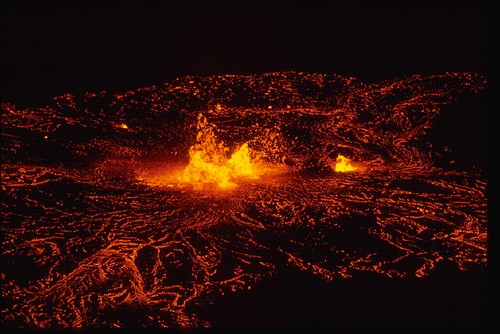Human activities put out in just three to five days, the same amount of carbon dioxide that volcanoes produce globally each year.
US Geological Survey scientist Terrance Gerlach, makes this calculation in a new article, “Volcanic Versus Anthropogenic Carbon Dioxide,” in this week’s issue of Eos, the American Geophysical Union’s weekly newspaper.
 Photo courtesy, DW Peterson/US National Park ServiceKilauea Volcano at Mauna Ulu, Hawai’i, when it erupted in 1972.
Photo courtesy, DW Peterson/US National Park ServiceKilauea Volcano at Mauna Ulu, Hawai’i, when it erupted in 1972.
“The most frequent question that I have gotten (and still get), in my 30 some years as a volcanic gas geochemist from the general public and from geoscientists working in fields outside of volcanology, is: ‘Do volcanoes emit more CO2 than human activities?’ Research findings indicate unequivocally that the answer to this question is ‘No — anthropogenic CO2 emissions dwarf global volcanic CO2 emissions,” says Gerlach.
In fact, calculations show that carbon emissions caused by human activities in 2010 — an estimated 35 gigatons — was about 135 times the average emissions from volcanoes during the same period (about 0.26 gigatons), he notes.
This new information places human activity as a major contributor to greenhouse gases. Deniers of human influence on climate change often cite carbon emissions from natural sources like, plants, animals and volcanoes, claiming they release way more carbon dioxide into the atmosphere than we do via our gas-guzzling and forest-razing lifestyles.
It’s true that the sum total of CO2 released from natural sources, especially plant and animal life, is way higher than what we humans put out through our activities (studies peg it at 20 times more), but, Gerlach explains, most of that carbon gets recycled and balanced out by natural carbon sinks, largely via photosynthesis of carbon compounds by plants.
“The carbon that’s really critical is not the carbon that’s recycled, but the carbon that’s new to the earth’s surface environment that doesn’t get recycled,” Gerlach told the Journal today. “One of the biggest natural sources of such carbon dioxide is volcanoes, the other is fossil fuel burning.”
Gerlach looked at five published studies of present-day global volcanic CO2 emissions that give a range of results — from a minimum of about one tenth of a billion metric tons, to a maximum of about half a billion metric tons of CO2 per year — and went with an average of one-quarter of a billion metric tons of volcanic CO2 per year. He then compared it to the estimated anthropogenic CO2 emission rate for 2010 — about 35 billion metric tons per year (calculated by a team from the University of Exeter, UK, led by carbon cycle expert Pierre Friedlingstein).
Gerlach’s calculations suggest present-day annual anthropogenic CO2 emissions exceed the carbon output of even one or more volcanic super-eruptions per year! (Super-eruptions are extremely rare. The most recent examples being the Toba eruption 74,000 years ago in Indonesia and the Yellowstone caldera eruption in the United States 2 million years ago.)
“Indeed, volcanoes emit significantly less CO2 than land use changes (3.4 gigatons per year), light-duty vehicles (3.0 gigatons per year, mainly cars and pickup trucks), or cement production (1.4 gigatons per year),” Gerlach writes in the Eos report. “This pattern… reflects the 650% growth in anthropogenic emissions since 1900, about 550% of which has occurred since 1950,” he writes.
Bottomline — Volcanoes’ big carbon burps are small deal in comparison to our CO2 output.
We don’t have a paywall because, as a nonprofit publication, our mission is to inform, educate and inspire action to protect our living world. Which is why we rely on readers like you for support. If you believe in the work we do, please consider making a tax-deductible year-end donation to our Green Journalism Fund.
Donate